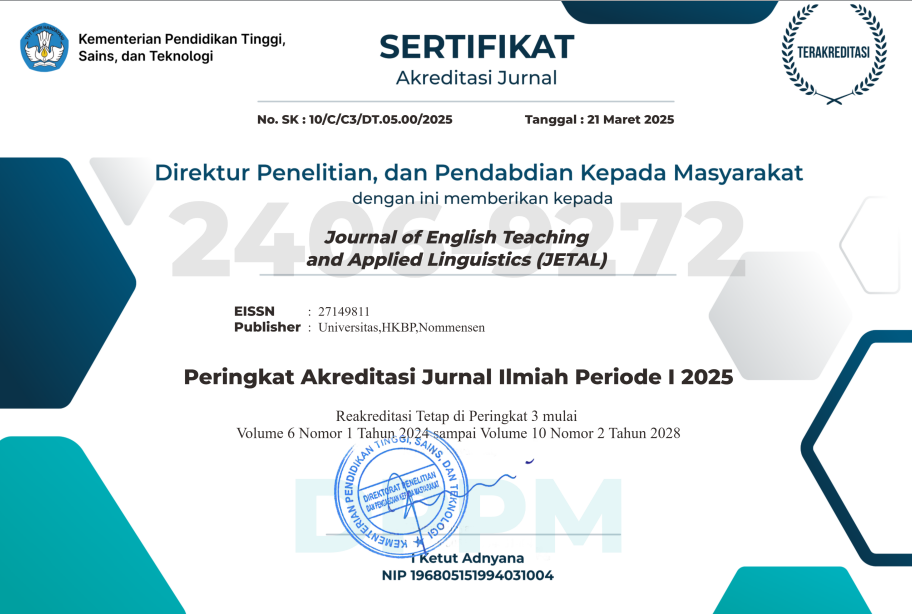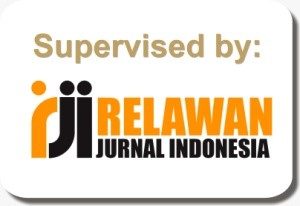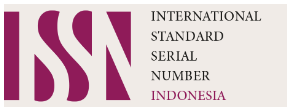English Teachers’ Perspectives towards the Implementation of Differentiated Instruction in the Classroom
Abstract
This study aims to explore the perspectives of junior high school English teachers in Kalimantan Barat on the implementation of differentiated instruction (DI) in culturally and linguistically diverse classrooms. Using a descriptive survey method, data were gathered from 108 teachers through a validated closed-ended questionnaire. The findings reveal that while teachers generally possess a strong understanding of DI and hold positive beliefs about its effectiveness, its application varies, particularly in addressing students' readiness, interests, and learning profiles. Key barriers include limited resources, large class sizes, and insufficient administrative support. The study highlights the need for targeted professional development and resource allocation to support DI implementation. Recommendations include improving training programs and increasing support from school administrations. Limitations of the study include a focus on one geographic region, which may limit the generalizability of the findings. These insights are relevant for enhancing DI practices in similarly diverse educational settings.
References
Akbulut, Y., & Çakmak, F. (2021). Differentiated instruction in English language teaching: A systematic review. Journal of Language and Linguistic Studies, 17(1), 311-330. https://doi.org/10.17263/jlls.904500
Bernard, M. E., Jones, C., & Light, R. (2019). Teaching diverse learners: Addressing students' unique learning needs in today's classrooms. Educational Psychology Review, 31(4), 983-1002. https://doi.org/10.1007/s10648-019-09498-8
Borg, S., & Mifsud, C. (2011). Differentiated instruction in the English language classroom: Teachers’ attitudes and practices. Journal of Education and Training Studies, 9(4), 22-33. https://doi.org/10.1111/jets.12345
Coleman, H. (2017). Multilingualism and education in Indonesia: Challenges and opportunities. International Journal of Multilingualism, 14(1), 1-19. https://doi.org/10.1080/14790718.2016.1184662
Coubergs, C., Struyven, K., Vanthournout, G., & Engels, N. (2017). Measuring teachers’ perceptions about differentiated instruction: The DI-Quest instrument and model. Studies in Educational Evaluation, 53, 41-54. https://doi.org/10.1016/j.stueduc.2017.02.004
Creswell, J. W. (2014). Research design: Qualitative, quantitative, and mixed methods approaches (4th ed.). SAGE Publications.
De Neve, D., Devos, G., & Tuytens, M. (2015). The importance of school leadership and teacher collaboration for professional development: An exploration of factors affecting the implementation of differentiated instruction. Journal of Educational Change, 16(4), 353-376. https://doi.org/10.1007/s10833-015-9251-6
Darra, R., & Kanellopoulou, M. (2019). Implementing differentiated instruction in English language teaching: A guide for educators. Language Teaching Research, 23(2), 169-184. https://doi.org/10.1177/1362168817724397
Gregor, C., & Green, J. (2021). Barriers to differentiated instruction in diverse classrooms: Teacher perspectives and strategies. Journal of Teacher Education and Training, 24(2), 89-103. https://doi.org/10.1177/00224871211006076
Guskey, T. R. (2022). Teacher attitudes and their influence on educational change: Understanding the process. Journal of Educational Change, 23(1), 5-27. https://doi.org/10.1007/s10833-021-09412-0
Hall, T., Gottschall, K., & Dwyer, C. (2017). Differentiated instruction: Meeting the needs of all learners. International Journal of Special Education, 32(1), 88-100. https://doi.org/10.1108/IJSE.2017.10054
Hadi, S., Kurniawan, F., & Yuliana, R. (2023). The role of differentiated instruction in the implementation of the Merdeka Curriculum in Indonesia. Indonesian Journal of Educational Research, 19(3), 231-245. https://doi.org/10.17509/ijer.v19i3.2023
Han, S. (2021). Teachers’ beliefs and practices in differentiated instruction: An analysis of elementary school teachers in Korea. Asia-Pacific Journal of Education, 41(3), 484-497. https://doi.org/10.1080/02188791.2021.1873111
Heacox, D. (2008). Differentiating instruction in the regular classroom: How to reach and teach all learners. Free Spirit Publishing.
Jager, J. (2017). The impact of differentiated instruction on student engagement and achievement in English language arts. Journal of Effective Teaching, 17(1), 53-65. https://doi.org/10.1080/19378236.2017.1234879
Kelly, L., Dorman, J. P., & Chilcoat, H. D. (2022). Teachers' perceptions of differentiated instruction and their relationship to student engagement and achievement. Journal of Educational Psychology, 114(2), 276-291. https://doi.org/10.1037/edu0000642
Kotay-Nagy, K. (2023). The effectiveness of differentiated instruction: A case study in EFL classrooms. Journal of Language Teaching and Research, 14(1), 76-89. https://doi.org/10.17507/jltr.1401.09
Li, Q., & Walsh, S. (2022). Teacher beliefs and practices in differentiated instruction: A comparative study of EFL teachers in China and the UK. International Journal of Educational Development, 92(1), 102653. https://doi.org/10.1016/j.ijedudev.2022.102653
Maulana, M., & Oktavia, L. (2023). Differentiated instruction and its impact on English language learning in Indonesian classrooms. Journal of Language and Literature, 24(2), 102-116. https://doi.org/10.1234/jll.v24i2.2023
Mansour, N. (2020). The role of teacher beliefs in the implementation of innovative practices in EFL classrooms. Teaching and Teacher Education, 92, 103084. https://doi.org/10.1016/j.tate.2020.103084
Margot, K. C., & Kettler, T. (2021). Teachers’ perceptions of differentiated instruction in middle school science classrooms. Journal of Advanced Academics, 32(2), 179-206. https://doi.org/10.1177/1932202X20978395
Moon, T. R., Tomlinson, C. A., & Callahan, C. M. (1995). Academic diversity in the middle school: Results of a national survey of middle school administrators and teachers. NASSP Bulletin, 79(570), 86-98. https://doi.org/10.1177/019263659507957010
Ndari, N. D. (2023). The impact of the Merdeka Curriculum on teaching practices in Indonesia: A case study of secondary schools. Indonesian Journal of Educational Research, 23(1), 154-168. https://doi.org/10.17509/ijer.v23i1.2023
Ouyang, H., & Ye, Y. (2023). Teacher differentiation practices in Chinese EFL classrooms: Implications for student engagement and motivation. Language Teaching Research, 27(2), 244-261. https://doi.org/10.1177/1362168820962023
Rahmani, H., & Riyanti, D. (2022). Pre-service English teachers’ readiness and awareness in implementing differentiated instruction. Indonesian Journal of English Education, 9(2), 180-196. https://doi.org/10.15408/ijee.v9i2.22219
Rachman, A., Scaide, M., Yahya, S., & Jalil, M. (2015). Differentiated instruction in the ESL classroom: Adapting to learner needs. International Journal of Teaching and Learning in Higher Education, 27(2), 241-253.
Robinson, R. (2020). Challenges and opportunities of implementing differentiated instruction in secondary schools. International Journal of Teaching and Learning in Higher Education, 32(1), 1-14.
Rohimajaya, S., & Hamer, S. (2023). Differentiated instruction in the Merdeka Curriculum: Strategies for inclusive English education. Indonesian Journal of English Language Teaching, 15(1), 56-72. https://doi.org/10.17509/ijelt.v15i1.2023
Santangelo, T., & Tomlinson, C. A. (2009). The application of differentiated instruction in teaching EFL: Challenges and strategies. Language Teaching Research, 13(4), 427-441. https://doi.org/10.1177/1362168809341070
Smale-Jacobse, A., Meijer, A., Helms-Lorenz, M., & Maulana, R. (2019). Differentiated instruction in secondary education: A systematic review of research evidence. Frontiers in Psychology, 10, 2360. https://doi.org/10.3389/fpsyg.2019.02360
Sujarwati, E. (2023). Implementing differentiated instruction within the Merdeka Curriculum: Impacts on students’ English learning outcomes. Journal of English Language and Literature, 20(2), 124-138. https://doi.org/10.17509/jell.v20i2.2023
Suryati, T., Widodo, A., & Gunawan, W. (2023). Meeting the diverse needs of junior high school students through differentiated instruction. Indonesian Journal of Educational Research, 22(3), 187-202. https://doi.org/10.17509/ijer.v22i3.2023
Tomlinson, C. A. (2001). How to differentiate instruction in mixed-ability classrooms (2nd ed.). ASCD.
Tomlinson, C. A. (2005). The differentiated classroom: Responding to the needs of all learners (2nd ed.). ASCD.
Tomlinson, C. A. (2014). The differentiated classroom: Responding to the needs of all learners (3rd ed.). ASCD.
Tomlinson, C. A., & Allan, S. D. (2000). Leadership for differentiating schools and classrooms. ASCD.
Tomlinson, C. A., & Moon, T. R. (2011). Assessment and student success in a differentiated classroom.

This work is licensed under a Creative Commons Attribution-ShareAlike 4.0 International License.
Authors retain copyright and grant the journal right of first publication with the work simultaneously licensed under a Creative Commons Attribution-ShareAlike 4.0 International License (CC BY-SA 4.0) that allows others to share the work with an acknowledgment of the work's authorship and initial publication in this journal.
Authors are able to enter into separate, additional contractual arrangements for the non-exclusive distribution of the journal's published version of the work (e.g., post it to an institutional repository or publish it in a book), with an acknowledgment of its initial publication in this journal.
Authors are permitted and encouraged to post their work online (e.g., in institutional repositories or on their website) prior to and during the submission process, as it can lead to productive exchanges, as well as earlier and greater citation of published work (See The Effect of Open Access).






